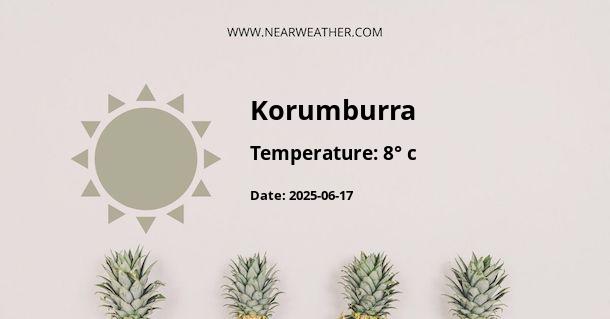Korumburra, Australia: Climate and Weather Year Round
Korumburra is a small town located in the South Gippsland region of Victoria, Australia. It is known for its picturesque landscapes, rolling green hills, and a moderate climate that attracts visitors throughout the year. In this article, we will explore the climate and weather patterns that shape Korumburra's unique environment.
Geographical Location
Korumburra is situated approximately 120 kilometers southeast of Melbourne, the capital city of Victoria. It is positioned in a valley surrounded by the Strzelecki Ranges, which shield the town from extreme weather conditions. This geographical location plays a significant role in shaping the local climate.
Temperate Climate
Korumburra experiences a temperate climate characterized by mild summers and cool winters. The region benefits from the moderating effect of the nearby ocean, which helps to keep temperatures relatively stable throughout the year.
The average annual temperature in Korumburra is around 14°C (57°F). During summer (December to February), temperatures typically range between 20°C and 25°C (68°F and 77°F), with occasional heatwaves pushing temperatures higher. In winter (June to August), temperatures range from 5°C to 15°C (41°F to 59°F), with colder nights occasionally dropping below freezing.
Rainfall Patterns
Korumburra receives a moderate amount of rainfall distributed fairly evenly throughout the year. The town experiences a temperate oceanic climate, which means it is influenced by both the Indian Ocean to the west and the Pacific Ocean to the east.
The average annual rainfall in Korumburra is around 1,000 millimeters (39 inches). The wettest months are typically from May to October, with June and July being the peak months. During this period, the town receives between 80 to 100 millimeters (3 to 4 inches) of rainfall per month. The summer months of December to February are relatively drier, with monthly rainfall averaging around 50 millimeters (2 inches).
Extreme Weather Events
While Korumburra generally experiences mild weather, it is not immune to extreme weather events that can occur in Australia. Bushfires and heatwaves are potential risks during the summer months, particularly when hot and dry conditions prevail. The surrounding forests and grasslands make the region susceptible to bushfire incidents.
On the other hand, during winter, Korumburra can experience heavy rainfall and occasional storms, which may lead to localized flooding. It is important for residents and visitors to stay informed about weather warnings and be prepared for such events.
Weather Averages
For a more detailed understanding of the weather patterns in Korumburra, the following table provides monthly average temperatures and rainfall:
| Month | Average Temperature (°C) | Average Rainfall (mm) |
|---|---|---|
| January | 22 | 40 |
| February | 22 | 40 |
| March | 20 | 50 |
| April | 17 | 65 |
| May | 14 | 75 |
| June | 12 | 90 |
| July | 11 | 95 |
| August | 12 | 90 |
| September | 14 | 80 |
| October | 16 | 70 |
| November | 18 | 60 |
| December | 20 | 50 |
Source: Bureau of Meteorology, Australia
Outdoor Activities
The mild climate of Korumburra makes it an ideal destination for outdoor activities year-round. Visitors can enjoy hiking, cycling, and exploring the scenic trails in the Strzelecki Ranges. The town also hosts various outdoor events and festivals, taking advantage of the pleasant weather.
Conclusion
Korumburra, Australia, offers a temperate climate with mild summers and cool winters. The town benefits from its geographical location, shielded by the Strzelecki Ranges and influenced by the nearby ocean. With its moderate rainfall and picturesque landscapes, Korumburra is a destination that offers enjoyable outdoor experiences throughout the year.
A - Korumburra's Latitude is -38.433331 & Longitude is 145.816666.
A - Weather in Korumburra is 33° today.
A - Climate Conditions in Korumburra shows clear sky today.
A - Humidity in Korumburra is 25% today.
A - Wind speed in Korumburra is 9.18 km/h, flowing at 221° wind direction. today.
